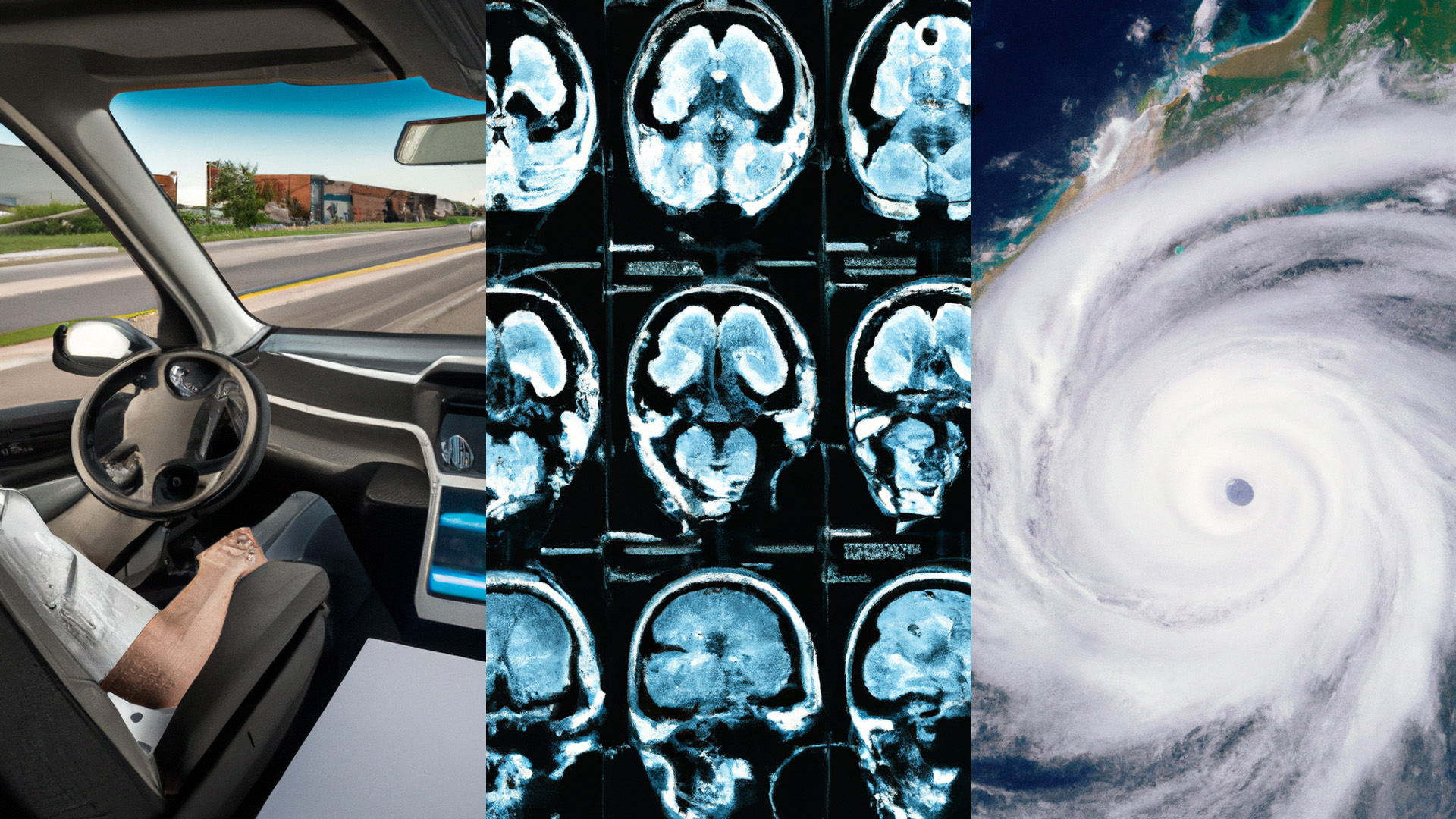
AI-generated images based on prompts “person sitting in self-driving car as it drives down street,” “MRI scan of human brain” and “satellite image of hurricane.” Credit: DALL-E, prompted by Jayme DeLoss
CSU experts: AI is empowering, disruptive and will bring benefits along with costs
story by Jayme DeLoss
published Aug. 31, 2023
With its ability to quickly process large amounts of data, artificial intelligence is being utilized in many fields to serve humanity. AI is aiding doctors with medical diagnoses. One study found that AI could improve breast cancer detection by 20%. It’s scanning satellite images more efficiently than people can, giving us advance notice about severe weather, and it’s automating many mundane tasks like these, so people can spend their time on more important pursuits.
AI is also keeping us safe on the road through technologies like blind-spot detection and adaptive cruise control. People are increasingly reliant on AI-based technology, even if they’re not aware of it.
Colorado State University Professor Bruce Draper, head of the Department of Computer Science, envisions many more beneficial uses for AI and is working to create applications to help people live longer, healthier, more satisfying lives. He’s also working with the Defense Advanced Research Projects Agency to defend AI systems against people with malintent.
“As civilians we’re all more and more dependent on technology,” Draper said. “We want to be able to make sure it’s safe and reliable.”
Draper said AI is an empowering tool that people can use to expand their skills. It can help us gain knowledge and be more productive. But it’s also a threat to the way we are used to doing things.
“Like every important breakthrough or new development, it’s going to change a lot of things, and it’s going to have both good and bad ramifications.”
Perpetuating biases – a very real harm
While some concerns about rapidly developing AI technology are valid, we don’t have to worry about a robot uprising any time soon. According to CSU computer scientists, including Draper and Assistant Professor Nikhil Krishnaswamy, AI doesn’t have intentionality, drive or reasoning; it only has association. “It finds and follows statistical patterns,” Draper explained.
Unfortunately, some of those statistical patterns could cause real harm to real people.
“The rhetoric about an existential threat is overlooking some real, more concrete but also more mundane harms that AIs can perpetuate,” Krishnaswamy said. He cited as examples the use of AI for facial recognition in law enforcement or loan decisions at a bank.
“The rhetoric about an existential threat is overlooking some real, more concrete but also more mundane harms that AIs can perpetuate.”
— Assistant Professor Nikhil Krishnaswamy
“Models are trained on biased data and reproducing biases, deciding who gets flagged on a closed-circuit television or who gets a bank loan and who does not,” Krishnaswamy said. “Those biases already exist in the data because they’re trained on data that has historical bias in it about who gets approval for a loan and who does not. That perpetuates real harm to real people.”
Draper and Krishnaswamy caution that we need to be careful in how AI is trained and how we interpret what it generates. “Just because what it generates looks good doesn’t mean that it is accurate,” Draper said.
He added that building in human control is a matter of good design.
“We’re trying to make the systems better,” Draper said, “and we’re trying to train people about AI so that they can use it in a way that is controllable, beneficial and ultimately trustworthy, because AI is a tool, and like any tool, it can be used for good or bad.”
Krishnaswamy emphasizes that humans built AIs, so we can decide when and how they are used.
“It’s incumbent upon us as a society to decide what sort of AI future we want to live in and decide where AI is going to be beneficial and where it is something that we do not want to be part of the decision-making process.”
Workforce impacts
While AI might not be a threat to our lives, it could threaten our livelihoods.
“Historically, new technologies have created more new jobs than they destroyed,” Draper said. “Is that still going to be true? It’s an open question we don’t know the answer to.”
Sociology Professor Patrick Mahoney has researched generative AI and workplace displacement. He examined Bureau of Labor Statistics speculations about the fastest growing jobs for 2021-2031 and found that with AI’s current and projected capabilities, some higher-order occupations could become automated.
“Historically, new technologies have created more new jobs than they destroyed. Is that still going to be true? It’s an open question we don’t know the answer to.”
— Professor Bruce Draper, head of the Department of Computer Science
Intellectual and creative jobs that involve creating content, like writing, art and scholarly work, were once considered safe from automation, but with generative AI programs that can produce plausible written and visual content almost instantly, some of these workers could be displaced. This is especially concerning, Mahoney notes, as the retail and service sectors decline with the rise of online shopping.
Mahoney said the question is: “Where do displaced workers go? Will they be able to be absorbed into the new virtual economy and become YouTube stars or something like that? Probably not.”
Despite concerns, Mahoney sees some upsides to the technology.
“There is the possibility that the simple, routine activities that we find unpleasant in our jobs could be automated, which then would allow us to be more creative in our work,” he said. “The other side of it is the idea that we could be displaced or marginalized in relationship to the type of creativity that is coming out of generative AI.”
AI Research
Artificial intelligence isn’t science fiction anymore. This special report from SOURCE explores the importance of AI research and what you really need to know about the potential and impact of this empowering, disruptive and complicated technology.